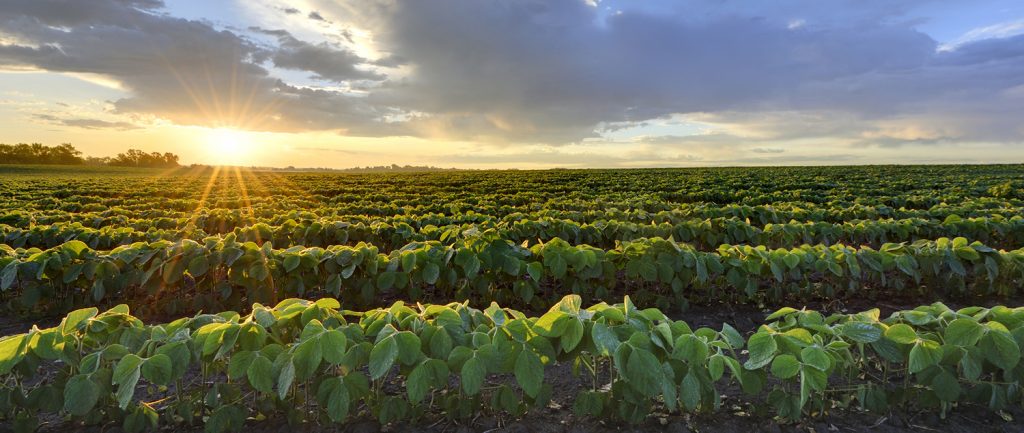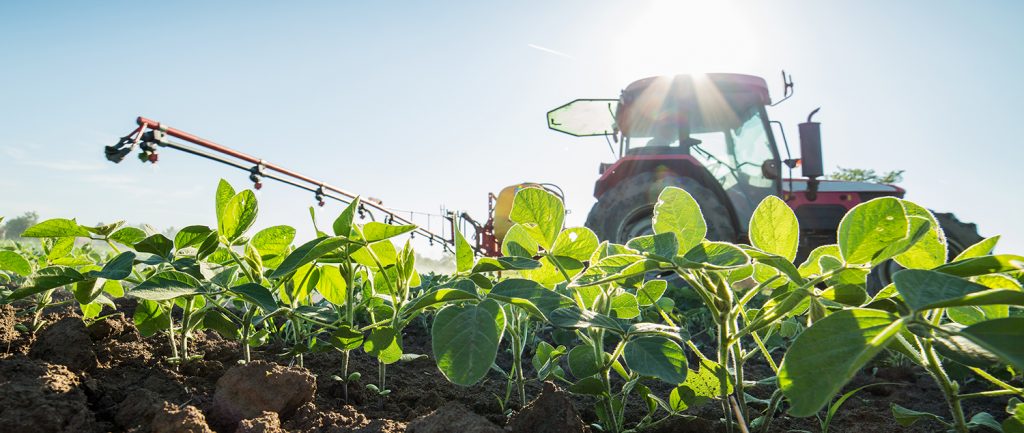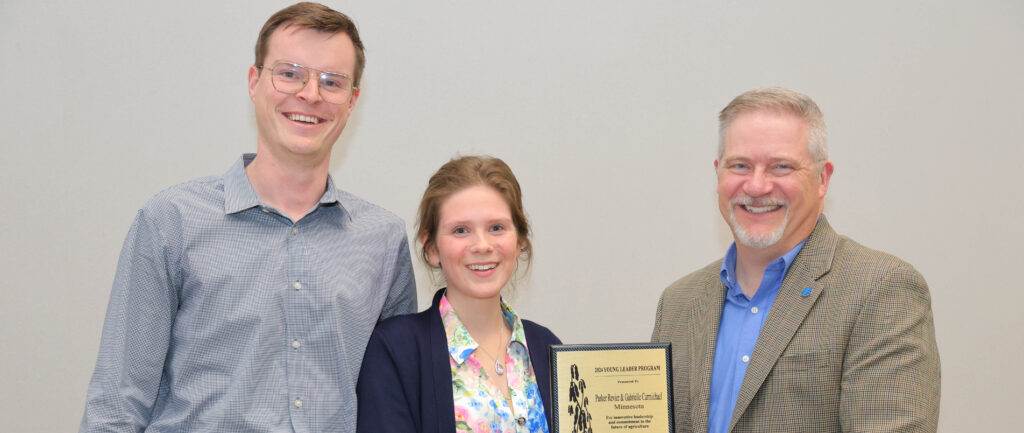Soybeans would receive exemption, get BMP credit
Minnesota Soybean Growers Association directors took to St. Paul Wednesday to talk priorities with Minnesota legislators, including Section 179 allowance conformity, buffer compensation, biodiesel and the ever-popular Nitrogen Fertilizer Rule.
On the heels of their visit, MSGA director Chris Hill, Brewster, Minn., along with MSGA staff, met with officials from the Minnesota Department of Agriculture (MDA) and other commodity groups to hear MDA’s proposed changes to the N Fertilizer Rule announced in 2017.
The changes come on the heels of a review of the comments MDA heard from nearly 1,500 attendees across 17 listening session throughout Minnesota, as well as 820 written comments the department received.
“The bottom line is addressing nitrate in groundwater is a very, very complicated issue,” said Dan Stoddard, MDA Section Manager, Pesticide and Fertilizer Management Division. “There is no simple solution, no silver bullet, and we understand that.”
Stoddard joined MDA Assistant Commissioner Susan Stokes, fellow MDA Pesticide and Fertilizer Management Division colleague Bruce Montgomery and MDA Commissioner Dave Frederickson in presenting the changes they are proposing to the N Fertilizer Rule, which the department has rebranded as the Groundwater Protection Rule.
“Minnesota is a huge state and we have significant differences in these lag times (the time between when action was taken on the surface to when results are measurable in wells) across the state,” he said. “In some cases they’re not very long; in some cases we’re talking decades from the action on the land surfaces and when you are going to see changes in water quality in the wells. It is incredibility complicated to deal with that. And it is something that is real, it is something we’re going to need to address and it is something we have considered in this plan.”
After reviewing the public comments from their 2017 rule proposal, MDA is considering the following changes to the Part 1 of the rule:
- Vulnerable soils are defined as:
- Coarse textured soils based on U.S. Department of Agriculture (USDA) Natural Resources Conservation Services (NRCS) soils maps (not KSAT)
- Shallow bedrock based on USDA NRCS soils maps (not DNR maps)
- Karst geology (no change)
- Added Drinking Water Supply Management Areas (DWSMAs) for public water supplies exceeding 5.4 mg/L nitrate‐N.
- Changed the mapped area subject to restrictions to quarter‐sections where 50 percent or more is vulnerable. Previously it was mapped by full sections.
- Added an exclusion for counties with low leaching potential based on precipitation and evapotranspiration rates and a short planting season.
- Added an exclusion for counties where less than 3 percent of the land is used for cropland.
- Increased the allowed nitrogen rate from 20 pounds to an average of 40 pounds per acre when applying ammoniated polyphosphate (MAP and DAP) or micronutrient formulations.
- Fields that have very low to low phosphorus levels are not subject to the 40 pounds per acre total nitrogen limit.
- Added exemptions for specific crops including winter grains, perennial crops, grass seed, cultivated paddy rice, and fall cover crops.
- Specified an effective date of Jan. 1, 2020 to provide enough notice for entities that need to order and ship fertilizer.
Additionally, the rule also deals with mitigation efforts for vulnerable areas, which are covered in Part 2: MDA is proposing:
- The rule will prioritize protecting DWSMAs. The goal is to prevent source water from exceeding the health standard of 10 mg/L nitrate‐N.
- There will be no regulatory component for townships.
- Voluntary Township Testing and Nitrogen Fertilizer Management Plan (NFMP) activities will continue to occur in townships, such as forming local advisory teams, promoting BMPs and evaluating BMP adoption.
- Mitigation level 2 DWSMA criteria decreased from 9 mg/L to 8 mg/L nitrate‐N.
- Criteria for moving up levels in DWSMAs now include:
- Increasing nitrate levels in groundwater, or
- Increases in residual soil nitrate below the root zone.
- The timeframe for evaluating changes in water quality has been modified to include the vertical lag time for nitrate to reach groundwater and travel time within an aquifer to reach the impacted well.
- Soybean acres are NOT included in the evaluation of BMP adoption.
- Commissioner’s Order
- DWSMA Level 3
- BMPs
- Alternative Management Tools (AMTs) may be required if funded.
- DWSMA Level 4 – Commissioner can order any practices allowed by the Groundwater Protection Act. These likely will be AMTs. There are two limitations:
- The Commissioner cannot restrict selection of the primary crop, and
- The nitrogen rate cannot be below the lowest University of Minnesota recommended rate.
- The Commissioner can grant a one‐time exemption to delay entering each regulatory level if ther is demonstrated progress.
“One thing we have changed is that when we are surveying acres, we will be excluding soybeans acres,” Stoddard said. “We had a number of comments that when evaluating soybean acres in most cases you are almost always guaranteed to meet the 80 percent (BMP) requirement. So what we have done is we will be crediting soybean acres and we will be approaching this from a crop rotation perspective, but the actual survey will be from crops other than soybeans.”
Mitigation Efforts
Stokes said there will be four levels of mitigation for vulnerable DWSMAs, two voluntary and two regulatory.
“Every DWSMA will be designated as a voluntary basis to start with,” Stokes said. “There will always be a voluntary beginning. It will move up to a regulatory framework if the BMPs in that DWSMA are not adopted of if the nitrate levels keep going up.”
When a DWSMA enters mitigation, it is up to the local advisory committee to determine the best course of action, which Stokes and Stoddard said will rely on local farmers and agronomists working together to institute BMPs or funded Alternative Management Tools (AMTs).
A DWSMA moves into regulatory status if after three growing seasons the Best Management Practices are not adopted on 80 percent of the cropland acres or after three growing season the residual soil nitrate below the root zone increases or after three growing season or the estimated lag time, whichever is longer, nitrate concentration continues to increase.
“The whole goal of this process, and it is important to not lose sight of this, is to work with local farmers to address local problems and understand and promote the best science” Stoddard said. “This is what we wanted from Day 1 and this is still what we want to do.”
Stokes pointed out that in the rule proposal, MDA cannot tell producers what crops to plant.
“We heard during the comment period from farmers asking if they weren’t going to be allowed to plant corn,” Stokes said. “And the answer to that is no. There were also comments saying you should just say that no corn can be grown in a DWSMA. We wanted to be specific about that and that is not going to be happening in this rule.”
New timeline
Stokes said there has been a push by commodity groups to get MDA to release the rule now so farmers can begin to understand what it all entails. Currently, MDA is targeting early May to release the rule.
“The question we are getting a lot is ‘Can’t you just get the rule published now,’” Stokes said. “We wish we could, but first, all the language has to be precisely drafted and it has to make its way through all those administrative stops before it can published. We are still shooting for early May but there are some things we just don’t have control over.”
She stressed that what was presented Tuesday wasn’t the final language of the rule. As is, the timeline for the rule release and adoption goes like this:
MDA will release the rule along with the Statement of Need and Reasonableness in early May, which triggers a formal comment period that will be no less than 30 days. During the summer, hearings will be held at various locations before an Administrative Law Judge (ALJ). Anyone can testify at these hearings.
Once the ALJ completes its report (potentially Fall 2018), MDA is allowed to respond to its report after which it will send the final rule to the Office of Administrative Hearings, the Office of the Revisor of Statutes, and the Governor, who would be expected to sign the final rule in January 2019.
Click here to view a draft of the vulnerable groundwater map.
MSGA takes to the Hill
MSGA President Michael Petefish asked Rep. Rod Hamilton, R-Mountain Lake, to support Rep. Jeff Backer’s (R-Brown’s Valley) House File 2887 bill, which would prohibit certain rules related to nitrogen fertilizer unless approved by law.
Petefish joined a contingent of MSGA directors Wednesday who talked to House and Senate members, urging them to support Rep. Backer’s bill on the House side and Sen. Mark Johnson’s (R-East Grand Forks) bill, Senate File 2720, in the Senate, which was heard Tuesday before the Senate Agriculture, Rural Development and Housing Policy Committee. MSGA and Minnesota Farm Bureau testified on SF2720.
“MSGA has been commenting on the rule and we appreciate the work MDA has done to modify the rule based on concerns it heard from farmers and stakeholders,” Petefish said. “Ultimately, it is appearing more and more like this rule is being forced through so Gov. Mark Dayton can sign it before leaving office. We are simply asking our legislators for oversight on such a complex topic. Minnesotans want clean water, farmers included, but we need sound science to make practical and feasible decisions that have meaningful impacts.”
MSGA directors also asked legislators for conformity on Section 179 allowances on farm machinery. The Federal Tax Cuts and Jobs Act expanded Section 179 allowances to make the first $1 million in expenditures on qualified property to be deducted in a year, up from $500,000. In Minnesota, which hasn’t conformed to increase the dollars amounts of Section 179 allowance since 2002, the deductibility is limited to $25,000.
MSGA also pressed legislators to reclassify land required to be placed into buffers as conservation rather than productive land for taxation.
“We’re not happy with the buffer law, but as it stands, we need to be compensated for our land,” Petefish told Rep. Hamilton.
Other topics discussed were biodiesel and the May 1 implementation of 20 percent biodiesel, health care, funding for mental health for farmers and transportation, including conformity with weight and axle limits to surrounding states, and a 150 mile exemption to the electronic logging rules.
“These regulations are killing us,” Petefish said. “Farmers can survive poor crop prices, but we can’t survive all the regulations, which I fear has us flirting with a 1980s scenario again.”





